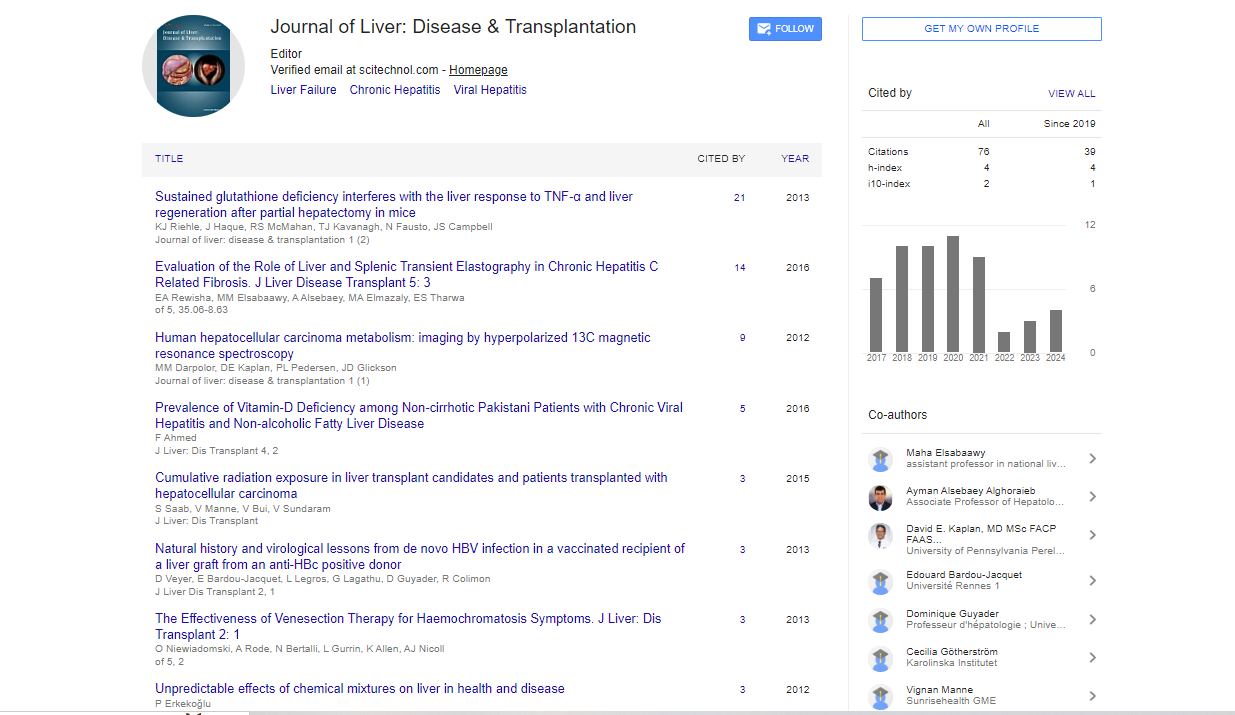Commentary, J Liver Disease Transplant Vol: 13 Issue: 1
A Comprehensive Analysis on the Intricacies of Liver Biopsy
Hikoma Wada*
1Department of Forensic Medicine, Nagoya City University Graduate School of Medical Sciences, Nagoya, Japan
*Corresponding Author: Hikoma Wada,
Department of Forensic Medicine,
Nagoya City University Graduate School of Medical Sciences, Nagoya, Japan
E-mail: wadahiko@k6.dion.ne.jp
Received date: 12 February, 2024, Manuscript No. JLDT-24-135117;
Editor assigned date: 14 February, 2024, PreQC No. JLDT-24-135117 (PQ);
Reviewed date: 28 February, 2024, QC No. JLDT-24-135117;
Revised date: 06 March, 2024, Manuscript No. JLDT-24-135117 (R);
Published date: 13 March, 2024, DOI: 10.4172/2325-9612.1000259.
Citation: Wada H (2024) A Comprehensive Analysis on the Intricacies of Liver Biopsy. J Liver Disease Transplant 13:1.
Description
The liver, an organ of remarkable complexity and vital importance in human physiology, plays a pivotal role in metabolism, detoxification, and homeostasis. Liver diseases, ranging from mild inflammation to severe cirrhosis, pose significant health challenges globally. To diagnose and manage these conditions effectively, clinicians rely on various investigative tools, with liver biopsy emerging as a cornerstone in elucidating histopathological changes. Liver biopsy entails the extraction of tissue samples from the hepatic parenchyma for histopathological examination. Historically, percutaneous needle biopsy has been the gold standard technique, involving the insertion of a biopsy needle through the skin and into the liver under ultrasound or Computed Tomography (CT) guidance. This approach offers high diagnostic accuracy and is relatively safe, with minor complications such as pain and bleeding being infrequent.
Moreover, advancements in interventional radiology have led to the refinement of image-guided biopsy techniques, including transjugular and laparoscopic approaches. Transjugular biopsy is particularly useful in patients with coagulopathy or ascites, as it avoids the risk of bleeding and allows simultaneous pressure measurement within the hepatic veins. Laparoscopic biopsy, although more invasive, offers precise tissue sampling under direct visualization, thereby enhancing diagnostic yield in select cases. Liver biopsy serves as a crucial diagnostic tool in a myriad of hepatic conditions, including but not limited to chronic hepatitis, liver fibrosis, cirrhosis, and hepatic tumors. In patients with chronic hepatitis B or C, liver biopsy aids in assessing disease severity, guiding treatment decisions, and predicting long-term outcomes. Similarly, in Non-Alcoholic Fatty Liver Disease (NAFLD) and Non-Alcoholic Steatohepatitis (NASH), biopsy remains indispensable for differentiating between simple steatosis and advanced fibrosis, thus informing risk stratification and therapeutic strategies.
Furthermore, liver biopsy plays a pivotal role in the evaluation of hepatic tumors, facilitating the distinction between benign lesions, primary malignancies, and metastatic disease. Histological analysis provides valuable insights into tumor grade, stage, and cellular characteristics, crucial for prognosis and treatment planning. Additionally, in the context of liver transplantation, biopsy is indispensable for assessing allograft viability, detecting rejection episodes, and monitoring post-transplant complications. The diagnostic utility of liver biopsy lies in its ability to provide accurate histological information, complementing biochemical, radiological, and serological assessments. Histopathological evaluation enables the characterization of inflammatory activity, fibrotic burden, architectural changes, and presence of necrosis or malignancy. Moreover, specific histological patterns, such as interface hepatitis in autoimmune liver diseases or Mallory-Denk bodies in alcoholic liver disease, offer diagnostic clues guiding targeted therapy and disease management.
Furthermore, liver biopsy facilitates the identification of concurrent histological features, such as steatosis, iron deposition, or granulomatous inflammation, which may influence disease progression and therapeutic response. Integration of histological findings with clinical data allows for personalized patient management, optimizing treatment efficacy and minimizing adverse outcomes. However, it is essential to acknowledge the inherent limitations of liver biopsy, including sampling variability, potential complications, and the need for experienced pathologists to interpret histological specimens accurately. In recent years, technological advancements have spurred the development of novel biopsy techniques aimed at enhancing safety, precision, and patient comfort.
One such innovation is the emergence of non-invasive alternatives to traditional liver biopsy, including transient elastography (FibroScan) and Magnetic Resonance Elastography (MRE). These modalities utilize advanced imaging techniques to assess liver stiffness, providing surrogate markers of fibrosis without the need for tissue sampling. Additionally, molecular profiling techniques, such as gene expression analysis and proteomic profiling, hold promise in augmenting the diagnostic accuracy of liver biopsy. By elucidating disease-specific biomarkers and molecular pathways, these approaches offer insights into disease pathogenesis, prognosis, and therapeutic targets. Furthermore, advances in artificial intelligence and machine learning algorithms are revolutionizing histopathological interpretation, enabling automated analysis of biopsy specimens with unprecedented speed and accuracy.
Conclusion
Liver biopsy remains a cornerstone in the diagnosis and management of various hepatic disorders, offering invaluable histological insights essential for personalized patient care. Despite the advent of non-invasive alternatives and evolving technologies, liver biopsy continues to occupy a central role in clinical practice, owing to its diagnostic accuracy, versatility, and prognostic significance. Moving forward, interdisciplinary collaboration and technological innovation will further refine biopsy techniques, ultimately improving patient outcomes and advancing our understanding of liver disease pathophysiology.
 Spanish
Spanish  Chinese
Chinese  Russian
Russian  German
German  French
French  Japanese
Japanese  Portuguese
Portuguese  Hindi
Hindi 